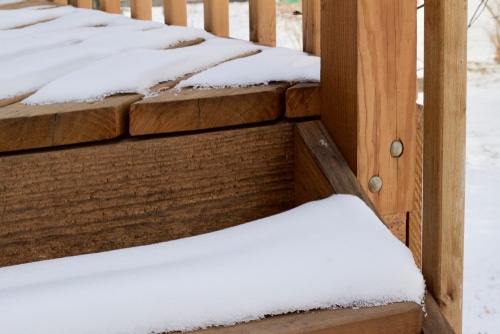Prepping Your Deck for Winter

Winter weather can be harsh on your deck, and proper maintenance is key to preventing damage. By following these simple steps, you can protect your deck from rain, snow and ice, so you'll be able to enjoy the outside of your home come spring.
Clean Your Deck
First, sweep your deck to remove dirt, leaves, and other debris, and use a putty knife to clean the spaces between the boards. Next you'll need to clean the surface boards. Use a scrub brush to remove mildew, algae, dirt, and rust. Specialty deck cleaners are available, but you can make your own by mixing together equal parts of warm water and bleach.
It's a good idea to remove any planters, as moisture can build up and lead to the development of mildew. If possible, store your patio furniture someplace dry, like your garage. Should you need to leave some pieces out, remove any pillows or cushions, and consider purchasing outdoor furniture covers. A cover can also protect your grill from winter weather damage.
Do an Inspection
The second step to take in prepping your deck for winter is to do a complete inspection of the surface boards, joists, posts, and railings. Check the surface boards and take note of any damaged areas. As your deck ages, some boards may become warped, but this isn't a major problem until they begin to crack. Boards can also sustain localized damaged due to water dripping off or trees or the eaves of a house. Replacing a few boards is a fairly easy task that most homeowners are able to complete themselves.
If you have any damaged surface boards, you'll want to evaluate the condition of the joists and posts underneath as well. Because this area of the deck isn't exposed to direct sunlight, moisture doesn't dry as quickly, and the wood can begin to rot. Rotted joists can cause your deck to start to sag, making the whole structure unsound. Should you need structural repairs, it's wise to let a professional contractor handle them.
Check the Stain
The paint or stain on your deck should repel water, so moisture doesn't get underneath of the coating and cause damage. Over time, however, coatings may start to peel, bubble, or fade. Evaluate the surface of your deck for these issues. Spot an area that you think may be peeling? Try putting a strip of tape over it and pulling it off. If pieces of coating stick to the tape, it's probably time to apply a new coat of stain.
Re-staining a deck is a job that many homeowners choose to tackle themselves, but if your deck is very large, you may want to call in a professional. In order to apply a new coat, you'll first have to sand or scrape off the old stain. Make sure you select a stain that is rated for the outdoors. It's best to do the application during dry weather, and ideally, you should put on two coats for maximum protection.








